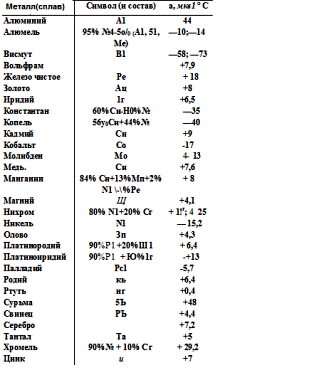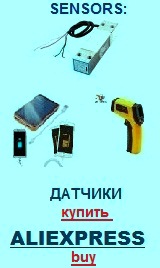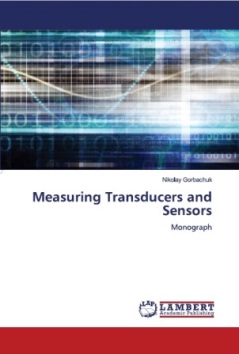Transducers, gauges, sensors - Information portal © 2011 - 2025 Use of material is possible by placing an active link


русский / english
Thermoelectricity of metals and semiconductors
Thermoelectric converters - generators of EMF
Thermoelectric cooling devices
Thermoelectric transducers
Home >>Temperature, thermoelectricity >> Thermoelectricity of metals and semiconductors
• Information about various converters and sensors of physical quantities, parameters of various physical processes is presented.
• Electrophysical properties and effects in various electrical materials.
• Theory, experimental results, practical application
Thermoelectricity of metals and semiconductors
In 1821 Seebeck opened the phenomenon, getting the name of thermo-electric effect. Essence of this phenomenon consists in the origin of electric current in the reserved chain, formed from different on composition explorers, at an obligatory condition, that the places of connection of explorers with each other have a different temperature. We will consider a next concrete example. We will make a chain from two pieces of steel and piece of copper wire.
Fig.1
If to solder ends wires these how it is shown on figs. 1, then the broken a secret chain middle part of which is formed by a copper wire will turn out. Let temperatures of ends steel wires and the first shut will have a the same value of temperature of Т1. If now to heat the second shut to the temperature of Т2, then on ends steel wires there will be a difference of potentials of U, the size of which is proportional to the difference of temperatures of Т2 - Т1 i.e. U = a(T2 - T1)
If instead of three wires to solder only two (steel and copper) and, as in the previous case, to heat a shut to the temperature of T2, and wires ends to support at the temperature of Т1 that on ends wires also will appear difference potentials. At shorting of such chain on a milliammeter the last will mark appearance of current which will flow continuously, if to support the difference of temperatures between the first and second shuts.
In the considered phenomenon the direct passing of thermal energy takes place to electric. In spite of it, extremely important feature, thermoelectricity during many years remained in the eyes of people rather by the amusing phenomenon, what by an important factor which can be used for the decision of large power problems. "Among the large openings of Oersted, Ampere and Faradey, - an academician А. F. Yoffe writes, - thermoelectricity came into a small notice. In future application of him to measuring of temperatures grew dark as compared to electromagnets, electric machines and transformers. So it and remained on the backyards of physics".
Position sharply changed only since, beginning approximately from 30th of our century, physicists began increased to study the thermo-electric phenomena in semiconductors.
Before to pass to the semiconductors, will consider, why difference of temperatures between the first and second the shuts of chain, made from three metallic wires, creates the difference of potentials. At first we will consider more simple case. If проволок ends from homogeneous material are at the different temperatures of Т1 and T2, then in this case electrons will move from more hot end of wire to her cold end in a greater number, what in retrograde. Hereupon a hot end will revive positively, and cold - negatively. Appearance positive and negative charges on the opposite ends of wire will result in appearance of electric-field, directed from the hot end of explorer to cold one. Because electrons diffuse from a hot end to cold in a greater number, what in retrograde, that results in the increase of accumulation positive and negative by volume charges, tension of electric-field in turn increases also. In spite of the continuously supported difference of temperatures, growth of charges on hot and cold parts of wire, eventually, will cease. It will happen because tension of electric-field will grow to such value which compensation forces of diffusion in future. As a result on the ends of wire at this difference of temperatures of Т2- Т1 the permanent difference of potentials will be set.
Some more difficult it will be in the case of two heterogeneous metals.
It was higher marked that the nascent difference of potentials, or so-called thermo-electromotive force, is proportional to the difference of temperatures. It is necessary from here, that the coefficient of thermo-electromotive force of an is numeral equal to the size of difference of potentials, arising up at the difference of temperatures in one degree. In general speaking, the coefficient of thermo-electromotive force of an in turn also depends on a temperature, however for some pair of metals this dependence is not strongly expressed.
For most metals the numeral values of an in general are small.
In a table.1 values over of an are brought for some metals and alloys in relation to platinum.
Table 1
Value of coefficient of thermoelectromotive force for some metals and alloys
Small numeral values and for all metals and were one of reasons that during 130 years from the moment of opening of the phenomenon of thermoelectricity it did not find power applications. Only in a thermometery a thermo-electric effect found wide and deserved confession. An output-input of metallic thermocouples ratio is usually calculated by the hundredth, and at the best tenth stakes of percent. It is explained by the unavailing spending of far of thermal energy, tricked into to the heated shut, and small value and, In metals the concentration of lone electrons practically remains permanent in a wide temperature range, and their kinetic energy small depends on a temperature. Therefore although at creation on the ends of metal of difference of temperatures there are terms for diffusion of electrons, but this diffusion is such, that the appearing difference of potentials is very small.
A completely other picture is observed in semiconductors. She so advantageously differs from that takes place in metals, that became possible to talk about realization of термоэлектробатарей, directly converting thermal energy into electric with a comparatively large output-input ratio. As is generally known, in semiconductors the concentration of transmitters of electricity considerably less than, than in metals at a room temperature. Then kinetic energy of transmitters of current in semiconductors grows with the increase of temperature stronger, than in metals. Unlike metals in semiconductors the concentration of transmitters of current quickly increases with a temperature. If at the absolute pitch of temperature there is not a not single electron in the area of conductivity, then even at room temperatures the concentration of transmitters of charges can arrive at a number in 10^20 on 1 sm^3.
These major differences of semiconductors from metals enable to look after thermo-electromotive forces in many semiconductors, in ten of one times greater, than in metals. Thus there is a next process. The transmitters of electricity, electrons or "holes", diffuse from more hot area of semiconductor, in which both their concentration and their kinetic energies matter very much in area of with the lowered temperature, where their concentrations and kinetic energies less than. On the other hand, there is moving of transmitters of current and in retrograde - from a cold end to hot one.
But in beginning of process, to the moment of establishment of dynamic equilibrium, number of transmitters, moving from a hot end to cold one, more than in retrograde. It over moving of charges brings to the enough rapid origin of surplus of positive charges on one end of semiconductor and surplus negative on his other end. Simultaneously with the increase of number of charges the difference of potentials increases between the extreme points of semiconductor. As well as in case considered higher with a metal, the increasing electric field will slow diffusion of charges from a hot end to хо-лодному, that, eventually, will result in the равновесному state: the streams of charges in both directions will be compared, and arising up here difference of potentials and will be thermo-electromotive force. In this process the p-type and electronic mechanism of 'Conductivity of semiconductor shows up with the special clearness. The hot end of p-type semiconductor revives negatively, and cold - positively, that corresponds to diffusion of holes from a hot area in cold one. In an electronic matter there is a reverse picture: a hot end revives positively, and cold negatively, that corresponds to diffusion of electrons from a hot end to cold one.
Unlike metals there is a coefficient of thermoelectromotive force, and at semiconductors considerably anymore and can arrive at values, exceeding 1000 mkV on a degree.

See also:
CONVERTERS, GAUGES, SENSORS
Information, news, advertising


